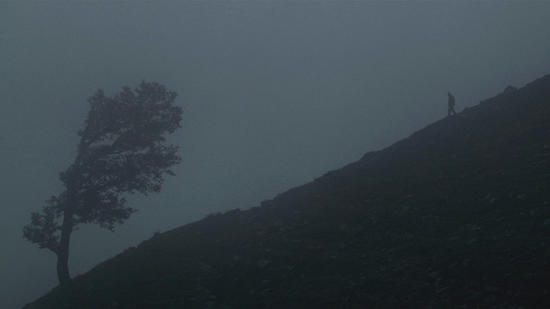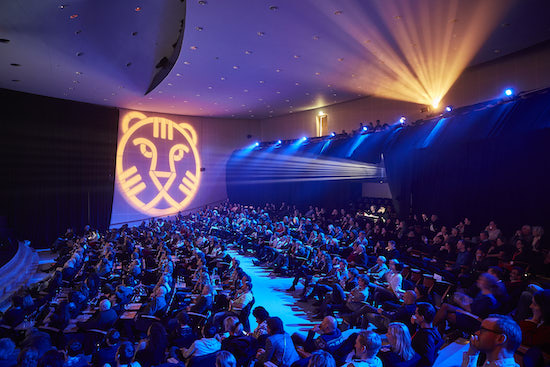On the drive in from the airport, we asked our driver, what’s a fun thing to do in Rotterdam? The man looked at us like were mad. “Watch movies,” he said.
As it approaches its half-century, with over 500 films screened to an audience in the hundreds of thousands, the International Film Festival Rotterdam can boast of being the largest ticketed cultural event in the Dutch calendar. “Everyone in Rotterdam knows,” our driver continued, “when you get to the end of January, that’s what you do: you watch movies.”
So we did.
Nobody does 3D quite like Philippe Parreno. The French artist’s No More Reality Whereabouts opens with the close-up face of Ann Lee, the anime character bought by Parreno and his compatriot Pierre Huyghe back in 1999. She self-referentially explains to us her own back-story (“I was bought for ¥46,000, paid to a design character company, K-Works…”), but, wearing 3D glasses, we see her face glitch and distort. Where a James Cameron or Joseph Kosinski might use the polarised glasses to more fully immerse their audience into their respective film worlds, to create a fuller, more lifelike cinematic experience; Parreno does exactly the reverse, using the stereoscope effect to jar and disturb, a high-tech verfremdungseffekt which feels like it is fucking directly with the cortical pathways between the eye and the brain.
Though No More Reality Whereabouts is essentially just a kind of greatest hits collection made up of films Parreno has previously shows in galleries, the mode of their compilation has been designed to explicitly address the conventions of cinema and of the film festival screening. No doubt about it, this is a movie, albeit a movie in which everything we expect from a film has been turned on its head. The film is here introduced by a live speaker – but not the director, or a festival spokesperson, instead an Indonesian “Dhalang” puppet master. There is live piano (from Mikhail Rudy), but it is not there to sub in for the absent sound of an otherwise silent film, but rather to supplement and confuse in various ways a soundtrack that is already fully present. There are characters without backgrounds and backgrounds without characters, objects and landscapes that seem more animate than the people that inhabit them. Parreno himself calls it a “séance of cinema”, exploding the rituals of film and summoning its ghosts. Dreamlike and disturbing, it made for a startling introduction to a festival in which every aspect of the film form would be questioned, and from every angle.

The Gold-Laden Sheep and the Sacred Mountain
Bero Beyer recalls making a short speech when he took over as director of the festival four years ago, in which he called for a celebration of a century and a half of cinema. “No, no, no,” one of the festival programmers chided him afterwards, “we need to go back much further than that.” The IFFR is a festival that refuses to stop at the invention of Auguste and Louis Lumière. Instead its tentacles extend out into deep time media archaeologies of the magic lantern, the phenakistoscope, the camera obscura, and phantasmagoria, making for a film festival that, as Beyer proudly proclaims, is more concerned with asking questions of its form than providing answers.
Take the exhibition, Blackout, that fills up one floor of the Rotterdam Kunsthall for the duration of the festival: a group show of artists work with the Kodak Carousel Slide Projector, with all works dating from after 2004, when the machine ceased production. Works by Praneet Soi and Aura Satz use the machine’s regular alternation of image and darkness as a metaphor for historical erasure, like the black boxes of the redactor’s pen. This is an exhibition less about what we see than what is left out, as in Nguyen Trinh Thi’s Landscape Series No.1 (2013) in which we witness a succession of figures gesturing in empty landscapes: a man in casual clothes and a military helmet pointing towards a fairly nondescript hill; a jungle, think with trees and lush vegetation viewed over the shoulder of a young short-haired woman, indicating nothing in particular. These are all found photographs, taken from Vietnamese newspapers, it apparently being the norm there for press photographers to arrive at scene somewhat after the fact, left with nothing to shoot but the space where something – who knows what – might once have taken place. The images are projected onto the gallery wall, clicking round regularly. Movement arrested, set once more into motion. We are deep in what Hollis Frampton once called the “infinite film” where film “may be defined operationally as ‘whatever will pass through a projector.’ The least thing that will do that is nothing at all.”
More historical caesuras in one of the strangest films I saw at the festival. Jagoda Szelc’s Monument sees a party of students (played by the graduating acting class from the National Film School in Łódź) arrive at a crumbling old hotel for an internship programme under the despotic control of an authoritarian manager (played by Dorota Lukasiewicz). As they clean rooms, launder sheets, prepare food, and wait tables, the film becomes a surreal study in toxic group dynamics and the terror of depersonalisation, a film about private rituals and secret pleasures. At its core, though, are a series of strange absences: characters with no names and no personal histories; an old woman – though repeatedly asked – who cannot speak of her wartime memories; a massive plinth that bears no statue. The film’s allegorical force and stark aesthetic is only let down by an unfortunate and misguided decision to provide a rather pat ‘explanation’ for the whole thing in the last five minutes. It would have been better off without.

That Cloud Never Left
Cendrine Robelin’s film La Lucarne des Rèves takes us deep into the inner life of sounds, the inner life of machines, and of the people who use them. The documentary tells the story of musique concrète from its origins amidst the rubble of World War II to the present day. For a little under an hour we watch the composers Bernard Parmegiani, Beatriz Ferreyra, Michel Chion, and Lionel Marchetti fidget – and sometimes fight – with tape recorders, mixing desks, microphones and other devices, or tramp through the French countryside tumbling stones and bothering bees. But it’s not really what we see here that makes this film compelling. It’s a film that makes good on Walter Ruttmann’s old promise of a cinema for the ears, reversing the standard economy of the senses.
Yashaswini Raghunandan’s That Cloud Never Left, as its opening intertitle makes clear, is shot entirely in “Daspara, one of those tiny villages in eastern India where people make toys and sell them in faraway cities for a living.” The film is fiction, but it has a documentary feel and the villagers of Daspara are its cast. The toys themselves “are made of cane, plastic, wires, papers, and cinema in a strange way.” We watch the villagers slicing up off-cut strips of 35mm film leftover from old Bollywood films and sticking them onto little bamboo sticks. They spin them before the light and the images flicker enchantingly, images and faces and colours and textures dancing before our eyes. That Cloud Never Left is a film about the fringes of the global economy, about a village with its own peculiar cottage industry whose raw materials are the leftovers from the global dream factory. But by incorporating the secondhand frames used by the villages into the film itself, projecting them over or in-between the shots of village life, it becomes also a kind of meta-cinema. We are back, once again, deep in Frampton’s “infinite film”.

Monument
My personal highlight from the festival was a picture notable for a different sort of economy. Shot in just three weeks, with no professional actors, and using entirely portable, solar-powered equipment, The Gold-Laden Sheep & the Sacred Mountain was a revelation. A masterpiece of minimalist film-making, Ridham Janve’s astonishing debut paints a wry and tender portrait of Himalayan goatherds, beautifully shot and immaculately paced. The film eschews much of what Hollywood expects of cinema. There is no third act complication, here, little in the way of character arcs, and nothing you could really call a resolution. It is all the more cinematic for it.
We had come here in search of movies. We found something more: a vibrant film culture in which art deco picture palaces adorned with gleaming neon lights are thronged with eager movie-goers, in which cinematic form is questioned and its limits repeatedly tested. If you’re going to San Francisco, you may need some flowers in your hair. But if you’re on your way into Rotterdam, be prepared to watch some movies.
The International Film Festival Rotterdam closes this weekend


